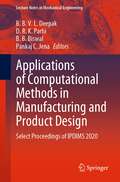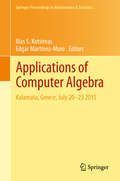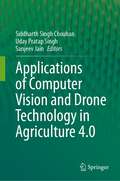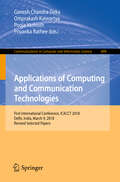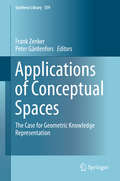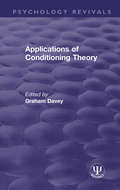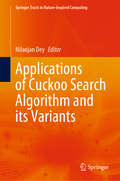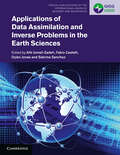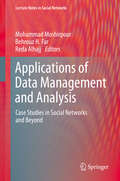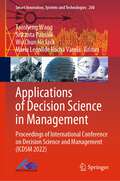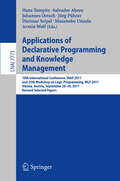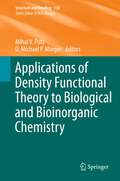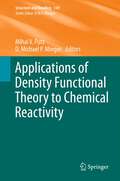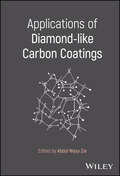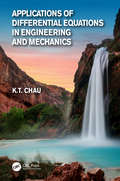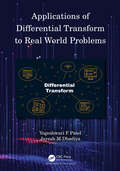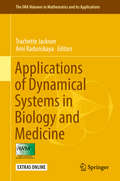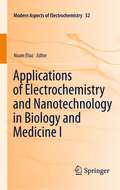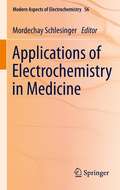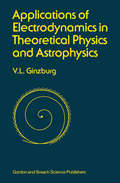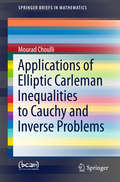- Table View
- List View
Applications of Computational Methods in Manufacturing and Product Design: Select Proceedings of IPDIMS 2020 (Lecture Notes in Mechanical Engineering)
by B. B. V. L. Deepak D. R. K. Parhi B. B. Biswal Pankaj C. JenaThis book presents the select proceedings of the conference of Innovative Product Design and Intelligent Manufacturing System (IPDIMS 2020), held at the National Institute of Technology, Rourkela, India. The book addresses latest methods and advanced tools from different areas of design and manufacturing technology. The main topics covered include computational methods for robotics, mechatronics and human-computer interaction; computer-aided design, manufacturing and engineering; aesthetics, ergonomics and UX/UI design; smart manufacturing and expert systems. The contents of this book will be useful for researchers as well as professionals working in the areas of industrial design, mechatronics, robotics, and automation.
Applications of Computational Tools in Biosciences and Medical Engineering (Advanced Structured Materials #71)
by Andreas Öchsner Holm AltenbachThis monograph presents the latest developments and applications of computational tools related to the biosciences and medical engineering. Computational tools such as the finite element methods, computer-aided design and optimization as well as visualization techniques such as computed axial tomography open completely new research fields with a closer joining of the engineering and bio/medical area. Nevertheless, there are still hurdles since both directions are based on quite different ways of education. Often even the "language" is sometimes different from discipline to discipline. This monograph reports the results of different multi-disciplinary research projects, for example, from the areas of scaffolds and synthetic bones, implants and medical devices and medical materials. It is also shown that the application of computational methods often necessitates mathematical and experimental methods.
Applications of Computer Algebra: Kalamata, Greece, July 20–23 2015 (Springer Proceedings in Mathematics & Statistics #198)
by Ilias S. Kotsireas Edgar Martínez-MoroThe Applications of Computer Algebra (ACA) conference covers a wide range of topics from Coding Theory to Differential Algebra to Quantam Computing, focusing on the interactions of these and other areas with the discipline of Computer Algebra. This volume provides the latest developments in the field as well as its applications in various domains, including communications, modelling, and theoretical physics. The book will appeal to researchers and professors of computer algebra, applied mathematics, and computer science, as well as to engineers and computer scientists engaged in research and development.
Applications of Computer Vision and Drone Technology in Agriculture 4.0
by Siddharth Singh Chouhan Uday Pratap Singh Sanjeev JainThis edited book focus on two most emerging areas and covers the different aspects of computer vision and drone technology in the field of agriculture. It comprises various applications including segmentation/classification of plant diseases, monitoring of crops, grade/quality estimation of fruits/flowers/vegetables/crops, surveillance, soil deficiency estimation, crop/plant growth estimation, canopy measurement, water stress management, vegetation indices calculation, weed detection, and spraying, among other. It has 17 chapters contributed by experts in the field of computer vision, drone technology, deep learning, machine learning, artificial intelligence, image processing, agriculturist, and plant pathologists. The recent development of high-end computing devices and the adaptation of unmanned aerial vehicles has provided a mechanism to automate traditional agriculture practices. The on-field or aerial images captured using cameras are processed with the help of intelligent algorithms, and an assessment is drawn for further recommendations. This practice is efficient in provisioning an accurate, timely, and economical decision-making system to overcome the problems of agricultural field experts and farmers. This process is advantageous in increasing the quality and quantity of crop yields. This book serves as an excellent guide to students, researchers, scientists, and field experts in directing their work toward this domain and developing/designing models. Further, this book is useful for pathologists, biotechnologists, seed production specialists, breeders, market managers, and other stakeholders associated with underlying technology or market development from the public and private sectors.
Applications of Computing and Communication Technologies: First International Conference, Icacct 2018, Delhi, India, March 9 2018 (Communications In Computer And Information Science #899)
by Priyanka Rathee Pooja Vashisth Omprakash Kaiwartya Ganesh Chandra DekaThis book (CCIS 899) constitutes the refereed proceedings of the First International Conference on Applications of Computing and Communication Technologies, ICACCT 2018, held in Delhi, India, in March 2018. The 30 full papers were carefully reviewed and selected from 109 submissions. The papers are organized in topical sections on communication and system technologies, computing and network technologies, application and services.
Applications of Computing, Automation and Wireless Systems in Electrical Engineering: Proceedings Of Marc 2018 (Lecture Notes in Electrical Engineering #553)
by Sukumar Mishra Yog Raj Sood Anuradha TomarThis book discusses key concepts, challenges and potential solutions in connection with established and emerging topics in advanced computing, renewable energy and network communications. Gathering edited papers presented at MARC 2018 on July 19, 2018, it will help researchers pursue and promote advanced research in the fields of electrical engineering, communication, computing and manufacturing.
Applications of Conceptual Spaces: The Case for Geometric Knowledge Representation (Synthese Library #359)
by Peter Gärdenfors Frank ZenkerThis volume provides an overview of applications of conceptual spaces theory, beginning with an introduction to the modeling tool that unifies the chapters. The first section explores issues of linguistic semantics, including speakers' negotiation of meaning. Further sections address computational and ontological aspects of constructing conceptual spaces, while the final section looks at philosophical applications. Domains include artificial intelligence and robotics, epistemology and philosophy of science, lexical semantics and pragmatics, agent-based simulation, perspectivism, framing, contrast, sensory modalities, and music, among others. This collection provides evidence of the wide application range of this theory of knowledge representation. The papers in this volume derive from international experts across different fields including philosophy, cognitive science, linguistics, robotics, computer science and geography. Each contributor has successfully applied conceptual spaces theory as a modeling tool in their respective areas of expertise. Graduates as well as researchers in the areas of epistemology, linguistics, geometric knowledge representation, and the mathematical modeling of cognitive processes should find this book of particular interest.
Applications of Conditioning Theory (Psychology Revivals)
by Graham DaveyThe area of applied psychology known as behaviour modification or behaviour therapy had progressed remarkably in the ten years, prior to publication. Illustrative of this progress is the variety of therapeutic and behaviour management techniques now available to the applied psychologist. This volume, originally published in 1981, describes some of the important characteristics of this development, and in particular, the relationship between behaviour change techniques and the principles of conditioning theory that generated them. This brief gives rise to three main themes. First, the book describes some of the reasons underlying the adoption of the conditioning paradigm and the epistemological advantages of the paradigm for behaviour modification. Second, a number of chapters discuss the current trends in specific areas of applied psychology where conditioning principles play an important heuristic role. These chapters deal with the uses made of conditioning theory in the areas of mental handicap, psychiatric therapy, work organizations, and the treatment of brain injury. Third, later chapters discuss some of the more recent theoretical developments in the field of behaviour modification/therapy, in particular the drift from strict behaviouristic applications of conditioning principles to more cognitive ones.
Applications of Cuckoo Search Algorithm and its Variants (Springer Tracts in Nature-Inspired Computing)
by Nilanjan DeyThis book highlights the basic concepts of the CS algorithm and its variants, and their use in solving diverse optimization problems in medical and engineering applications. Evolutionary-based meta-heuristic approaches are increasingly being applied to solve complicated optimization problems in several real-world applications. One of the most successful optimization algorithms is the Cuckoo search (CS), which has become an active research area to solve N-dimensional and linear/nonlinear optimization problems using simple mathematical processes. CS has attracted the attention of various researchers, resulting in the emergence of numerous variants of the basic CS with enhanced performance since 2019.
Applications of Data Assimilation and Inverse Problems in the Earth Sciences (Special Publications of the International Union of Geodesy and Geophysics #5)
by Alik Ismail-Zadeh Fabio Castelli Dylan Jones Sabrina SanchezMany contemporary problems within the Earth sciences are complex, and require an interdisciplinary approach. This book provides a comprehensive reference on data assimilation and inverse problems, as well as their applications across a broad range of geophysical disciplines. With contributions from world leading researchers, it covers basic knowledge about geophysical inversions and data assimilation and discusses a range of important research issues and applications in atmospheric and cryospheric sciences, hydrology, geochronology, geodesy, geodynamics, geomagnetism, gravity, near-Earth electron radiation, seismology, and volcanology. Highlighting the importance of research in data assimilation for understanding dynamical processes of the Earth and its space environment and for predictability, it summarizes relevant new advances in data assimilation and inverse problems related to different geophysical fields. Covering both theory and practical applications, it is an ideal reference for researchers and graduate students within the geosciences who are interested in inverse problems, data assimilation, predictability, and numerical methods.
Applications of Data-Centric Science to Social Design: Qualitative and Quantitative Understanding of Collective Human Behavior (Agent-Based Social Systems #14)
by Aki-Hiro SatoThe intention behind this book is to illustrate the deep relation among human behavior, data-centric science, and social design. In fact, these three issues have been independently developing in different fields, although they are, of course, deeply interrelated to one another. Specifically, fundamental understanding of human behavior should be employed for investigating our human society and designing social systems. Insights and both quantitative and qualitative understandings of collective human behavior are quite useful when social systems are designed. Fundamental principles of human behavior, theoretical models of human behavior, and information cascades are addressed as aspects of human behavior. Data-driven investigation of human nature, social behavior, and societal systems are developed as aspects of data-centric science. As design aspects, how to design social systems from heterogeneous memberships is explained. There is also discussion of these three aspects—human behavior, data-centric science, and social design—independently and with regard to the relationships among them.
Applications of Data Management and Analysis: Case Studies in Social Networks and Beyond (Studies in Big Data #27)
by Reda Alhajj Behrouz H. Far Mohammad MoshirpourThis book addresses and examines the impacts of applications and services for data management and analysis, such as infrastructure, platforms, software, and business processes, on both academia and industry. The chapters cover effective approaches in dealing with the inherent complexity and increasing demands of big data management from an applications perspective.Various case studies included have been reported by data analysis experts who work closely with their clients in such fields as education, banking, and telecommunications. Understanding how data management has been adapted to these applications will help students, instructors and professionals in the field. Application areas also include the fields of social network analysis, bioinformatics, and the oil and gas industries.
Applications of Decision Science in Management: Proceedings of International Conference on Decision Science and Management (ICDSM 2022) (Smart Innovation, Systems and Technologies #260)
by Taosheng Wang Srikanta Patnaik Wu Chun Ho Jack Maria Leonilde Rocha VarelaThis book covers research trends of data science and management involving cutting edge technologies and novel research directions from diverse fields of industries, business and government sectors. It involves usage of various advanced tools and techniques for understanding different data collected at the grassroot level to generate actionable insights for making crucial decisions. This book aims to serve as a reference book for researchers in the area of decision science for management. It covers alternative solutions with innovative ideas and issues from different fields of business management.
Applications of Declarative Programming and Knowledge Management: 19th International Conference, INAP 2011, and 25th Workshop on Logic Programming, WLP 2011, Vienna, Austria, September 28-30, 2011, Revised Selected Papers (Lecture Notes in Computer Science #7773)
by Hans Tompits Salvador Abreu Johannes Oetsch Jörg Pührer Dietmar Seipel Masanobu Umeda Armin WolfThis book constitutes revised selected papers of the 19th International Conference on Applications of Declarative Programming and Knowledge Management, INAP 2011, and the 25th Workshop on Logic Programming, WLP 2011, held in Vienna, Austria, in September 2011. The 19 papers presented in this volume were carefully reviewed and selected from 27 papers presented at the conference and initially a total of 35 submissions. The book also contains the papers of two invited talks. The papers are organized in topical sections on languages; answer-set programming and abductive reasoning; constraints and logic programming; answer-set programming and model expansion; application papers; and system descriptions.
Applications of Density Functional Theory to Biological and Bioinorganic Chemistry (Structure and Bonding #150)
by Mihai V. Putz D Michael MingosThe series Structure and Bonding publishes critical reviews on topics of research concerned with chemical structure and bonding. The scope of the series spans the entire Periodic Table and addresses structure and bonding issues associated with all of the elements. It also focuses attention on new and developing areas of modern structural and theoretical chemistry such as nanostructures, molecular electronics, designed molecular solids, surfaces, metal clusters and supramolecular structures. Physical and spectroscopic techniques used to determine, examine and model structures fall within the purview of Structure and Bonding to the extent that the focus is on the scientific results obtained and not on specialist information concerning the techniques themselves. Issues associated with the development of bonding models and generalizations that illuminate the reactivity pathways and rates of chemical processes are also relevant. The individual volumes in the series are thematic. The goal of each volume is to give the reader, whether at a university or in industry, a comprehensive overview of an area where new insights are emerging that are of interest to a larger scientific audience. Thus each review within the volume critically surveys one aspect of that topic and places it within the context of the volume as a whole. The most significant developments of the last 5 to 10 years should be presented using selected examples to illustrate the principles discussed. A description of the physical basis of the experimental techniques that have been used to provide the primary data may also be appropriate, if it has not been covered in detail elsewhere. The coverage need not be exhaustive in data, but should rather be conceptual, concentrating on the new principles being developed that will allow the reader, who is not a specialist in the area covered, to understand the data presented. Discussion of possible future research directions in the area is welcomed. Review articles for the individual volumes are invited by the volume editors. Readership: research scientists at universities or in industry, graduate students Special offer For all customers who have a standing order to the print version of Structure and Bonding, we offer free access to the electronic volumes of the Series published in the current year via SpringerLink.
Applications of Density Functional Theory to Chemical Reactivity (Structure and Bonding #149)
by D. Michael Mingos Mihai V. PutzThe series Structure and Bonding publishes critical reviews on topics of research concerned with chemical structure and bonding. The scope of the series spans the entire Periodic Table and addresses structure and bonding issues associated with all of the elements. It also focuses attention on new and developing areas of modern structural and theoretical chemistry such as nanostructures, molecular electronics, designed molecular solids, surfaces, metal clusters and supramolecular structures. Physical and spectroscopic techniques used to determine, examine and model structures fall within the purview of Structure and Bonding to the extent that the focus is on the scientific results obtained and not on specialist information concerning the techniques themselves. Issues associated with the development of bonding models and generalizations that illuminate the reactivity pathways and rates of chemical processes are also relevant. The individual volumes in the series are thematic. The goal of each volume is to give the reader, whether at a university or in industry, a comprehensive overview of an area where new insights are emerging that are of interest to a larger scientific audience. Thus each review within the volume critically surveys one aspect of that topic and places it within the context of the volume as a whole. The most significant developments of the last 5 to 10 years should be presented using selected examples to illustrate the principles discussed. A description of the physical basis of the experimental techniques that have been used to provide the primary data may also be appropriate, if it has not been covered in detail elsewhere. The coverage need not be exhaustive in data, but should rather be conceptual, concentrating on the new principles being developed that will allow the reader, who is not a specialist in the area covered, to understand the data presented. Discussion of possible future research directions in the area is welcomed. Review articles for the individual volumes are invited by the volume editors. Readership: research scientists at universities or in industry, graduate students Special offer For all customers who have a standing order to the print version of Structure and Bonding, we offer free access to the electronic volumes of the Series published in the current year via SpringerLink.
Applications of Diamond-like Carbon Coatings
by Abdul Wasy ZiaAn incisive guide to diamond-like carbon (DLC) coatings and their contemporary applications In Applications of Diamond-like Carbon Coatings, distinguished researcher Dr. Abdul Wasy Zia delivers an insightful and up-to-date discussion of the latest advancements in new and non-conventional applications of diamond-like carbon (DLC) coatings. The editor explains the transformation of typical topics into advanced applications of DLC, including tribology for future transportation solutions, green lubrication, invasive implants, MEMS, optical devices, and more. The book also details advanced and contemporary trends in DLC coatings, like material informatics involving artificial intelligence and machine learning, and new, net-zero applications, including energy storage batteries. Readers will also find: A thorough introduction to applications of DLC coatings in mechanics, transportation, medicine, and electrical and optical device manufacture Comprehensive explorations of emerging trends in DLC coatings, including green energy, data-centric approaches, textile and plastics, and carbon circularity from DLC coated productsPractical discussions of how small and medium industries can design and develop DLC coatings for broad engineering applications Complete treatments of the benefits and opportunities presented by DLC coating applications Perfect for postgraduate students and researchers with an interest in DLC coatings, Applications of Diamond-like Carbon Coatings will also benefit scholars and instructors in academia, technical managers, scientists, engineers, and corporate research and development professionals with backgrounds in chemistry, materials science, polymer chemistry, and physical chemistry.
Applications of Differential-Algebraic Equations: Examples and Benchmarks (Differential-Algebraic Equations Forum)
by Achim Ilchmann Timo Reis Volker Mehrmann Stephen CampbellThis volume encompasses prototypical, innovative and emerging examples and benchmarks of Differential-Algebraic Equations (DAEs) and their applications, such as electrical networks, chemical reactors, multibody systems, and multiphysics models, to name but a few. Each article begins with an exposition of modelling, explaining whether the model is prototypical and for which applications it is used. This is followed by a mathematical analysis, and if appropriate, a discussion of the numerical aspects including simulation. Additionally, benchmark examples are included throughout the text.Mathematicians, engineers, and other scientists, working in both academia and industry either on differential-algebraic equations and systems or on problems where the tools and insight provided by differential-algebraic equations could be useful, would find this book resourceful.
Applications of Differential Equations in Engineering and Mechanics
by Kam Tim ChauThis second of two comprehensive reference texts on differential equations continues coverage of the essential material students they are likely to encounter in solving engineering and mechanics problems across the field - alongside a preliminary volume on theory. This book covers a very broad range of problems, including beams and columns, plates, shells, structural dynamics, catenary and cable suspension bridge, nonlinear buckling, transports and waves in fluids, geophysical fluid flows, nonlinear waves and solitons, Maxwell equations, Schrodinger equations, celestial mechanics and fracture mechanics and dynamics. The focus is on the mathematical technique for solving the differential equations involved. All readers who are concerned with and interested in engineering mechanics problems, climate change, and nanotechnology will find topics covered in this book providing valuable information and mathematics background for their multi-disciplinary research and education.
Applications of Differential Transform to Real World Problems
by Yogeshwari F Patel Jayesh M DhodiyaThis book is an invaluable resource for applied researchers to find the analytical solution of differential equations describing the dynamical system with less computational effort and time. It describes the basic concepts of the differential transform method and solution of various real-world problems described by simple to complicated differential equations. It provides a computational technique that is not only conceptually simple and easy to use but also readily adaptable for computer coding. Different chapters of the book deal with the basic differential equations involved in the physical phenomena as well as a complicated system of differential equations described by the mathematical model.The book offers comprehensive coverage of the most essential topics, including Basic concepts and fundamental properties of the proposed technique with proof The solution of linear, nonlinear, homogeneous, and nonhomogeneous ordinary differential equations (ODEs) and partial differential equations (PDEs) The initial and boundary value problems Real-world ODE and PDE problems are also discussed Applications of Differential Transform to Real World Problems is primarily aimed at undergraduates, graduates, and researchers studying differential equations. Scientists dealing with complicated differential equations or systems of differential equations will also find this book useful.
Applications of Dynamical Systems in Biology and Medicine (The IMA Volumes in Mathematics and its Applications #158)
by Trachette Jackson Ami RadunskayaThis volume highlights problems from a range of biological and medical applications that can be interpreted as questions about system behavior or control. Topics include drug resistance in cancer and malaria, biological fluid dynamics, auto-regulation in the kidney, anti-coagulation therapy, evolutionary diversification and photo-transduction. Mathematical techniques used to describe and investigate these biological and medical problems include ordinary, partial and stochastic differentiation equations, hybrid discrete-continuous approaches, as well as 2 and 3D numerical simulation.
Applications of Electrochemistry and Nanotechnology in Biology and Medicine I (Modern Aspects of Electrochemistry #52)
by Noam EliazThe study of electrochemical nanotechnology has emerged as researchers apply electrochemistry to nanoscience and nanotechnology. These two related volumes in the Modern Aspects of Electrochemistry Series review recent developments and breakthroughs in the specific application of electrochemistry and nanotechnology to biology and medicine. Internationally renowned experts contribute chapters that address both fundamental and practical aspects of several key emerging technologies in biomedicine, such as the processing of new biomaterials, biofunctionalization of surfaces, characterization of biomaterials, discovery of novel phenomena and biological processes occurring at the molecular level.
Applications of Electrochemistry in Medicine (Modern Aspects of Electrochemistry #56)
by Mordechay SchlesingerMedical Applications of Electrochemistry, a volume of the series Modern Aspects of Electrochemistry, illustrates the interdisciplinary nature of modern science by indicating the many current issues in medicine that are susceptible to solution by electrochemical methods. This book also suggests how personalized medicine can develop.
Applications of Electrodynamics in Theoretical Physics and Astrophysics
by David GinsburgTreats certain problems and methods of theoretical physics and astrophysics which are associated with microscopic and macroscopic electrodynamics and material concerning the theory of transition radiation and transition scattering.
Applications of Elliptic Carleman Inequalities to Cauchy and Inverse Problems (SpringerBriefs in Mathematics)
by Mourad ChoulliThis book presents a unifiedapproach to studying the stability of both elliptic Cauchy problems and selectedinverse problems. Based on elementary Carleman inequalities, it establishesthree-ball inequalities, which are the key to deriving logarithmic stabilityestimates for elliptic Cauchy problems and are also useful in proving stabilityestimates for certain elliptic inverse problems. The book presents three inverseproblems, the first of which consists in determining the surface impedance ofan obstacle from the far field pattern. The second problem investigates the detectionof corrosion by electric measurement, while the third concerns thedetermination of an attenuation coefficient from internal data, which ismotivated by a problem encountered in biomedical imaging.
